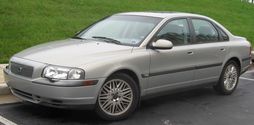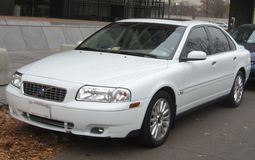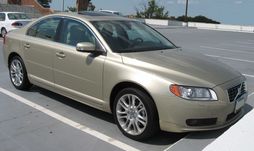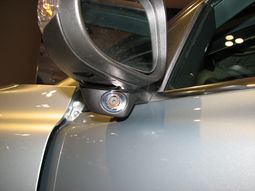The History Of Volvo S80

The Volvo S80 is a high-end car from Swedish automaker Volvo and was introduced in 1998 as a replacement for the rear-wheel drive Volvo 960/ S90 sedan. The Volvo S80 was built at the Torslanda Plant (Torslandaverken) in Gothenburg, Sweden. Unlike most Volvo models, it did not have a station wagon version for its first generation. Now, the third generation V70 wagon is marketed as the estate version for the second generation S80 sedan. This is a part of a major product overhaul at Volvo, including a most luxurious large estate and sedan.
It is notable for being one of the first Volvos to depart from the company's traditionally boxy, conservative styling. The S80's styling, with its pronounced beltlines and tail lights that narrow and go from curves to points as they go up, has been adopted throughout the Volvo line, especially on the S60 and S40 sedans.
The first generation Volvo S80 had one of the highest crash test ratings in the world for five years.[citation needed] The second generation Volvo S80 in June 2007 scored the highest "good" rating in the IIHS crash test performance for frontal, side, and rear impacts , continuing in the success of the first S80 sedan. The second generation S80 is better engineered than the outgoing model, in part due to a stiffer more rigid chassis.
The first generation S80 is based on the Volvo P2 platform. More than 368,000 first generation S80s were built before the introduction of the new model.
This S80 sedan being Volvo's flagship model was heavily equipped with numerous safety systems to ensure all occupants safety, including SIPS and WHIPS.
The S80 has three firsts for passenger cars. The first was the use of a built-in, fully integrated GSM phone, complete with both a hands free function and a lift-up hand-set. The second was the fitment of the straight six engine in a transverse mounting. Volvo claims to be the first manufacturer to succeed in mass producing this configuration "in modern time", although British Leyland produced passenger cars using the E6 engine from 1970 to 1981 in cars such as the Austin Princess. No existing manual gearbox would fit in the engine bay with the six cylinder engine, so Volvo had to develop their own, claimed to be the world's smallest manual gearbox, the M65. The previous record holder was also a Volvo gearbox, the M56 developed to fit the wide 5 cylinder transverse engine first used in the 850 series cars. Thirdly, the S80 was the world's first car with an environmental specification, covering aspects such as those directly relating to the car such as allergens from textiles and fuel economy and the life cycle of the car from production to dismantling.
For Volvo, the S80 was a major step forward into the age of modern car design, particularly with the use of multiplex wiring.
The S80 was initially available with four different engines. Starting the range was a detuned 2.4-litre 140hp 5-cylinder. This was also available as a CNG and as an LPG version. The fully tuned version produced 170PS (125kW). Next up was a 2.9L 196PS (144kW) 6-cylinder, then 272PS (200kW) T6 and finally, the 140PS (102kW) 2.5L TDI (diesel). The 2.9 has a Straight-6 engine while the T6 was powered by a destroked twin-turbocharged version. In 2000 there was the addition of the 200hp (149kW) 2.5T, available with standard all-wheel drive. The 2.5T model featured a light-pressure turbocharger. Late 2001 introduced the 163PS (120kW) 5 cylinder common rail diesel D5, detuned to 130PS (96kW) and sold as 2.4D in some markets. In some European countries the entry level S80 came with a 2.0 litre five-cylinder turbocharged engine producing 182 PS. These were sold in countries where larger capacity engines were penalized by heavy taxes.
Engines
On January 31, 2006, Volvo unveiled the first pictures of the second generation S80. Generally all features of the car were upgraded substantially. The new S80 will feature a new 3.2L straight-6 or 4.4L V8 engine in combination with available four-wheel drive. The second-generation S80 is the first Volvo sedan model to become available with Volvo's compact, transversely fitted V8 with a power output of 316PS (232kW) and 440N•m of torque developed jointly by Volvo Cars engine unit Skövde and Yamaha but built by Yamaha of Japan. With four catalytic converters and advanced electronics, this engine, which was first introduced in the Volvo XC90, is one of the cleanest V8s on the market. The exterior is similar to that of the first generation but is greatly improved with more high strength boron steel in the body for safety. The interior is seen as one of the most comfortable in the automotive industry. A long wheelbase version called the Volvo S80L was launched in China in November 2008 and is 140mm longer, with all of the extra length used to increase rear passenger legroom.
This second generation S80 is no exception to Volvo's on going improvements and inventions of safety. The second generation S80 has been given the IIHS 2007 Top Safety Pick Award in overall safety protection. Also again in November the IIHS awarded the 2008 Volvo S80 with Top Safety Award. This S80 performed outstandingly above its German and Japanese rivals. Scores were perfect for frontal, side, and rear impacts. The car was unveiled at the Geneva Motor Show on February 28, and sales began on June 2006. The new S80 is based on the Ford EUCD platform (called P24 by Volvo), also used for vehicles including Ford's S-MAX, Mondeo and Galaxy large MPVs. Some of these Ford vehicles, whilst sharing this platform, and some parts, are distincly different from each other as they compete in different auto market segments. Volvo vehicles on this platform tend to use more high tech parts and more expensive underpinnings.
Volvo's Personal Car Communicator (PCC) remote control will also be an optional feature with the new S80. This feature is fairly new to the automotive industry. Before a driver gets to their car, they are able to review the security level and know whether they have set the alarm and if the car is locked. Additionally, there is a heartbeat sensor that warns if someone is hiding inside the car.
The all new S80 is the first Volvo model to feature Adaptive cruise control (ACC) with Collision Warning and Brake Support (CWBS). Adaptive cruise control helps ensure comfort and relaxed driving by letting the driver select the desired speed and the minimum time gap to the vehicle in front of them. When a radar sensor detects a slower vehicle in front of them, Adaptive Cruise Control adapts to that vehicle by applying the brakes as necessary. As the Collision Warning System senses an impending collision, it alerts with a flashing light on the windshield and an audible alarm. Meanwhile Brake Support offers additional assistance by preparing the braking system so that the car can begin stopping faster and avoid a potentially dangerous situation before it happens. Volvo S80 is also available with a new safety innovation called Blind Spot Information System (BLIS, first seen in Volvo S40) which senses when a person enters the drivers blind spot and Active Bi-Xenon Lights (ABL) to illuminate around curves in the dark. Volvo is known for making historic strides in the production of intuitive new safety systems. BLIS system has been recently introduced at Mercedes-Benz higher specifications cars,nearly two years after Volvo. The second generation Volvo S80 is much more luxurious than the previous generation, and it flaunts its "Scandinavian Luxury" design language. The second generation S80 has already won awards in best mid size luxury sedan interior.
Engines
From Wikipedia, the free encyclopedia
More About Volvo S80




|